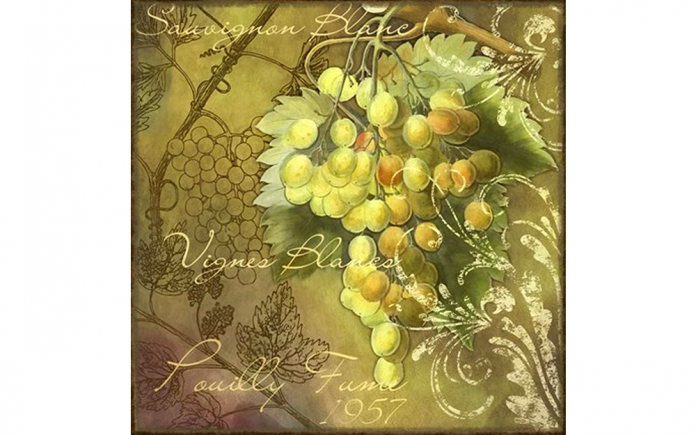
By Rick Riozza
Don’t be fooled. A Fumé Blanc is a Sauvignon Blanc. It happens so often: When a customer requests me to recommend a nice Sauv blanc, I’ll point out, among others, some tasty Fumé Blanc on the shelves; and then, they will invariably correct me and say, “No—I’m interested in a Sauvignon Blanc.” I know—don’t sweat the small stuff.
It must be the heat of the desert here in the Coachella Valley that has affected my mind. It seems that my last several articles have been on red wines—albeit, delicious red wines, but out here in the desert, right after Spring has sprung, we’re knee deep in heat! We should be talking about some refreshing white wine with our weather!
So are we happy now? Let’s do enjoy some refreshing crisp white wine: Fumé Blanc. So why is there another name for the settled Sauv Blanc. “Ah!” —you say, “it must be French.” And that’s fair. Fumé is a word in French referring to a smoke-like vapor or substance, and, blanc of course means white.
But there really is no “fumé blanc” produced in France. There is the very famous Pouilly-Fumé wine appellation for the dry sauvignon blanc white wine produced around Pouilly-sur-Loire in the Loire Valley, and that wine is usually compared to the also famous Sancerre, Pouilly’s neighbor on the Loire River.
But the fun story for wine enthusiasts is that decades ago, Robert Mondavi wanted to increase the interest of Sauvignon Blanc. Back in the 60s, when Americans were beginning to warm up to everyday wine consumption, Sauv Blanc was hardly a wine anyone had heard of. Sure, it was around since the late 1800s, but it was considered a boring variety, mainly used for sweet wine production which satisfied most Americans back then.
But, leave it to the great Robert Mondavi, both wine maker and businessman, to recognize the potential of the grape and decided to produce a quality dry Sauvignon Blanc in 1960s. Thinking outside of the box, Mondavi decided to invent another name for the variety. So there you go—fumé blanc was born! Hey—that’s how you do it!
But let me digress a bit since we’re all talking about Sauv Blanc anyway. For wine enthusiasts who like to dig a bit deeper, you’ll appreciate the distinctions: Pouilly-Fumé vs. Sancerre.
Pouilly-Fumé tends to be a little broader, softer, slightly less vibrant and aromatic than Sancerre. It can have a smoky character, especially those from flinty soils, but this can also be true of Sancerre grown on flint.
Both Pouilly-Fumé and Sancerre, especially the good ones, have grass and citric characters – typically grapefruit – rather than the classic notion of cat’s pee, which in the Loire is a sign of unripe grapes. In ripe, hot years stone-fruit characters emerge. The differences are nuanced and subtle.
I like the poetic difference the late Kit Stevens, Master of Wine, declared: “Pouilly-Fumé like summer – meaning that Sancerre is more immediately approachable in its youth, but with Pouilly-Fumé, you have to wait.
‘Pouilly-Fumé is more mineral, a connoisseur’s wine. It was very famous in the 1980s and ’90s, until Sancerre eclipsed it in popularity – maybe partly because Sancerre is easier to pronounce.” The best thing is to try them together and see if you can taste the differences.
Okay—back to California Fumé Blanc. In one sense, there is a difference in that name as compared to Sauv Blanc (oh-no—didn’t we spend time saying there isn’t?). Well—here it is: The primary difference comes after the wine has been produced and how it is aged. Fumé Blanc is a Sauvignon Blanc that is typically aged in oak barrels after fermentation while Sauv Blanc is traditionally aged in stainless steel vats after fermentation.
But remember, legally speaking there is no distinction. You can call this that, and that this. In other words, Fumé Blanc is not necessarily oaked.
The result is Fumé might have a slight amount more body than that of Sauv Blanc, which on the other hand is known to be fruity, clean and bright on the palate. Wines that are aged in oak barrels are generally fuller-bodied. These usually have higher viscosity, thus they leave a heavy and rich feeling on the palate. Generally speaking—taste wise, Sauv Blanc has got its herbaceousness, Fumé comes of with more rounded fruit, such as melons and mangos.
As I looked down my wine aisle, I see two national brands that have Fumé Blanc on their label (and for that matter, each label has also the name Sauvignon Blanc on it!):
2021 Ferrari-Carano Fumé Blanc, ($15) This is a blend of Sauv Blanc grapes from Sonoma County—Dry Creek, Alexander, Russian River and Knights Valley. When the grapes arrive at the winery, each lot is gently crushed and pressed into stainless steel tanks for 48 hours of cold settling. The juice is either transferred to stainless steel tanks or older French oak barrels for fermentation. The wine in barrels is sur lie aged and stirred every other week for two months, then blended and bottled.
This wine opens with enticing aromas of guava, apricot, lychee, and Meyer lemon. The palate is crisp and juicy, offering ripe pineapple, mango, peach, and fresh lemon cream flavors. The bottle is certainly a favorite of our desert crowd; they buy this up all day long.
The next bottle is an example of utilizing the Fumé Blanc name, but it’s made completely in stainless steel! 2021 Dry Creek Vineyard Fumé Blanc, ($15). It is certainly a delicious wine: Aromatics of lime, lemon, white peach and grapefruit leap forward from the glass with nuances of honeydew, lemongrass and white tea. On the palate, the wine is intense and bright with tangerine, passionfruit, and cucumber. The underlying minerality, hints of hibiscus, lemon verbena and jalapeño contribute to this wine’s refreshing, crisp finish. Cheers!










































